
French Connections: Music from the Parisian Stage

French Connections: Music from the Parisian Stage
The title Les Baricades Mistérieuses is probably meant to be evocative rather than a reference to a specific object, musical or otherwise. Scott Ross, in a master class filmed and distributed by Harmonia Mundi, likens the piece to a train. This clearly cannot have been the precise image Couperin was trying to convey, but it is easy to hear in Les Baricades the image of a heavy but fast-moving object that picks up momentum. In that sense, the mysterious barricades are perhaps those which cause the “train” to slow down and sometimes stop.
The piece could almost be seen as a catalogue of the effects that can cause an energetic line (the piece is marked vivement) to slow down or stop naturally and elegantly: through the imperfect and perfect cadences at the end of each couplet, the cadence resulting in a unison E flat in the third couplet, the introduction and modification of sequences in both the treble and bass (third couplet), and through some of the more “unexpected” harmonies like the diminished D chord in the first couplet. This hypothesis seems to fit in with the pedagogical aims of Couperin’s music, since the composer presents himself as something of a specialist in building sound through legato, style luthé playing.
© Luke Arnason
1. Prélude
2. Forlane
3. Menuet
4. Rigaudon
Although being performed today as a four-part orchestral suite, the original version of Le Tombeau de Couperin was not conceived in this way. Instead, when Ravel first wrote it between 1914 and 1917, he created a six-part piano suite with each movement dedicated to a different friend of his, who had fallen in World War I. Ravel himself did not undertake armed combat having been rejected from the Air Force on grounds of health, but instead drove a lorry as part of the Motor Transport Corps. He was still deeply affected by the war, his feelings deepened by the loss of his mother in 1917 to whom he had come to rely on. Although these pieces do not appear directly mournful, it can perhaps be argued that the choice of instruments, particularly the prominence of the double reed, creates a slightly melancholic tone among the more lively textures. Perhaps the pieces are meant to be remembrances of the lives of his friends rather than laments for their deaths.
The suite itself is seen as a homage to 18th century French music, hence the title (The Tomb of Couperin). Ravel’s embracing of the 18th century was part of a wider trend in France at the time to look back towards the Golden Age of Louis XIV, a time when the country was united and powerful. Rather than being pure imitation, however, the work has a definite neoclassical twist to it with each movement combining elements of the baroque era with more 20th century features. For example, throughout the work, contemporary style harmonies such as major 7ths feature while there is also an impressionistic texture created at times, through the use of the shimmering harp glissandos and harmonics. These fit into the more traditional baroque setting that Ravel creates, among other ways, through the use of clear and structured forms and by the imitation of sounds from the time. For example, the Menuet contains an imitation of the sound of a musette, a small bagpipe with a soft sound played by bellows. This instrument was extremely popular in 18th century France. The second movement, Forlane, also features the rhythm and articulation of a historical dance of the same name, used by Couperin in one of his Concerts Royaux. The dance is very structured but with a syncopated feel to it which adds interest. In this movement, it is the rhythm not the melody that is important.
The final movement, Rigaudon, is also named after a popular 18th century French dance which again features in the work. The movement is split into two halves with the bright Riguadon taking up the first half before a simpler C minor and Pastoralesque section takes over. The Riguadon returns at the end to finish the work.
© Roz Surtees
2. Adagio assai
3. Presto
Ravel wrote two piano concertos – this work, and the concerto ‘for the left hand’ written for the pianist Paul Wittgenstein, who had lost an arm in the First World War. Ravel composed the two pieces simultaneously in 1930 and 1931, but they are very different, in part because of the unusual demands writing for a one-handed pianist imposed on the composer, and the distinctive dark timbre inevitably resulting from a work weighted towards the bass end of the piano.
The G major Concerto was written for Marguerite Long, and she gave its first performance in Paris, with Ravel conducting, in 1932. It is in the conventional three movements (unlike the Left Hand work, which is in one continuous section), and from its opening shows the important influence of jazz on Ravel’s style by this point in his life. Ravel had, famously, refused to give Gershwin composition lessons on learning how much the younger man earned, saying he could teach him nothing useful, but it is clear that Gershwin’s own works, and in particular Rhapsody in Blue, had meant much to Ravel. The prominent melody for E flat clarinet with piano accompaniment is the most direct reference to Gershwin, but the whole movement owes its atmosphere to the jazz age of the 1920s, combined with Ravel’s reverence for Mozart and his compatriot Saint-Saëns.
The slow movement is a gorgeous song, stated initially by the piano and then taken up by the cor anglais, with the strings accompanying. This is music which speaks entirely for itself, and gains nothing from any attempt at analysis. The finale returns to the mood of the opening movement, with an even greater ‘swing’, and enormous wit and bravura. The piano writing is always brilliant and vivacious, and the movement brings the work to a wholly satisfying conclusion.
© Ian Lush
The bronchial pneumonia that struck Lili Boulanger at the age of 2 resulted in constant ill health and a life that lasted less than 25 years. Her parents, and her famous and widely respected sister, the teacher and conductor Nadia, were trained and active musicians. She too displayed phenomenal musical talent, which her devoted family did everything to encourage. When she won the prestigious Prix de Rome at 19—she was the first woman to win it for music—it made international headlines. Her physical condition severely restricted her ability to answer the growing demand for her music. She created a small but consistently intriguing and attractive catalog of music that, to quote Claude Debussy, “undulates with grace.” It includes songs and choral works, piano and chamber pieces, and a handful of orchestral compositions.
She composed the companion works D’un soir triste (On a Melancholy Evening) and D’un matin de printemps (On a Spring Morning) in 1917 and 1918. Shortly after composing the small-ensemble original versions, she transcribed them for orchestra. They were, alas, the final pieces she wrote with her own hand. The manuscripts, with their tiny notes, betray the increasing severity of her illness.
A vast emotional gulf lies between them. D’un soir triste is almost funereal in its mood and its dark palette of colors, and it swells up to several harsh climaxes. It may reflect Boulanger’s awareness that death was imminent. The sharply contrasting and much briefer D’un matin de printemps is sweet, playful, and transparently scored.
© Don Anderson
Debussy rescued the harp from a relatively subservient role in the nineteenth century orchestra where it usually appeared as one of many instrumental ingredients in the sonorous crescendos of mainstream composers. In a language favouring imagination rather than realism, transparency of texture rather than richness through doubling, the harp could again become a solo instrument asserting its most individual personality.
These dances scored for harp and strings were composed in 1904 at the request of Pleyel, the inventor of the chromatic harp, for a competition at the Brussels Conservatory. They exhibit in no small measure Debussy’s extraordinary understanding of the nature and technique of the instrument and the small string orchestra, often reduced to a string quartet, is treated with taste and sensibility.
© Michael Whewell
1. Allegro assai
2. Andante
3. Allegro
In March 1778 Mozart visited Paris for the third time in his life. On his arrival he found that he was no longer received with open arms. The reason was that he had evidently ceased to be the delightful infant prodigy of the past. He began to despise the Parisians who had formerly adored him, and he was shocked by the futile quarrels between the supporters of the two composers Gluck and Puccini. Having visited Mannheim on his way to Paris, where he had heard the excellent resident orchestra, he found the standard of musicianship in Paris deplorable. More serious was the fact that his former patrons had lost interest in him, and that his hopes of securing a permanent employment in the city were unfounded. But the worst blow was that his mother, who had always been a great comfort to him, was no longer able to give him the support he needed. She fell ill soon after his arrival in Paris and died there on 3 July 1778.
Mozart made desperate efforts to overcome these adversities, though Baron Grimm, who had been his principal protector in the past, did not think so: “He is too naïve, too inactive, too easily taken in, too little concerned with working for the future,” he wrote to Leopold Mozart, Wolfgang’s father.
How wrong Grimm was (at least as regards Mozart’s efforts to achieve success) was proved by the music of the Paris Symphony. The work was deliberately conceived to have the elegant style and the kind of brilliance which were all the rage in Paris at the time. The Allegro movements were, in fact, very well received at the first performance on 12 June 1778, but the gentle Andante (originally Andantino) was not appreciated. In order to show how eager he was to please, Mozart composed another Andante for a performance of the same work two months later. He could not have done more.
© Stefan de Haan
Violin 1
Simon Blendis
Jessica Coleman
Nicoline Kraamwinkel
Anna de Bruin
Hatty Haynes
Martin Smith
Violin 2
Gemma Sharples
Clare Hayes
Jeremy Metcalfe
Jayne Spencer
Nemanja Ljubinkovic
Viola
Judith Busbridge
Sophie Renshaw
George White
Oliver Wilson
Cello
Leo Popplewell
Sarah Butcher
Daisy Vatalaro
Double Bass
Benjamin Russell
Catherine Elliott
Flute
Michael Cox
Rebecca Larsen
Oboe
Gareth Hulse
Katie Clemmow
Clarinet
Tim Lines
Lewis Graham
Bassoon
John McDougall
Emma Harding
Horn
George Strivens
Martin Grainger
Trumpet
Alan Thomas
Peter Wright
Trombone
Andrew Cole
Timpani
Benedict Hoffnung
Percussion
Rachel Gledhill
Richard Horne
Matthew Turner
Keyboard
Martin Ennis
Harp
Rosanna Rolton
CHIEF EXECUTIVE
Flynn Le Brocq
CONCERTS
Artistic Projects Manager Sophie Haynes
Orchestra Manager & Fixer Jason Weir
Artistic Projects Coordinator Alex Mackinder
DEVELOPMENT
Development Manager Tristen Hennigs
Fundraising & Operations Peter Wright
Fundraising Consultant Paul Hudson
Outreach & Evaluation Consultant Bec Britain
Honorary Chair – Friends of LMP Christine Robson
MARKETING
Senior Marketing & PR Manager Anna Bennett
Marketing and Development Coordinator Bethany Penny
Digital Marketing Manager Charles Lewis
EVENTS
Royal Event Manager Rachel Rae
Freelance Events Producer Sophie Branscombe
FINANCE
Bookkeeper Debbie Charles
Leader Debbie Beckerman & Keith Jones
Leader Sophie and Jeffrey Prett
Co-Leader Michael Southwell
Violin 1.3 Liz and Alistair Milliken
Violin 1.4 currently not sponsored
Violin 1.5 Christine Robson
Violin 1.6 Della Brotherston
Violin 1.7 currently not sponsored
Violin 1.8 currently not sponsored
Violin 1.9 currently not sponsored
Associate First Violin currently not sponsored
Principal Second Violin currently not sponsored
Violin 2.2 The Angel Family
Violin 2.3 Mia and Keith Ball
Violin 2.4 Alastair Fraser
Violin 2.5 currently not sponsored
Violin 2.6 Catherine Shaw – Allbone and Trimit
Associate Second Violin currently not sponsored
Principal Viola Mark and Vanessa Petterson
Co-Principal Viola currently not sponsored
Viola 3 Gill Cox
Viola 4 currently not sponsored
Associate Viola currently not sponsored
Principal Cello Anonymous
Sub-Principal Cello Leslie Aarons
Cello 3 Gillian Noble
Cello 4 Richard Morgan
Associate Cello Colin and Helen Snart
Associate Cello currently not sponsored
Principal Double Bass John Clarke
Co-Principal Double Bass The Bristow Family
Principal Flute currently not sponsored
Sub-Principal Flute Raymond Calcraft
Principal Oboe Pat Sandry
Co-Principal Oboe currently not sponsored
Sub-Principal Oboe currently not sponsored
Principal Clarinet Deirdre Lea
Sub-Principal Clarinet Graham Harman
Principal Bassoon currently not sponsored
Sub Principal-Bassoon Barbara Tower
Principal Horn currently not sponsored
Sub-Principal Horn Chris Harman
Principal Trumpet Ishani Bhoola
Sub-Principal Trumpet Cynthia Harrod-Eagles
Principal Trombone currently not sponsored
Sub-Principal Trombone currently not sponsored
Principal Bass Trombone currently not sponsored
Principal Timpani Cynthia Harrod-Eagles
Principal Percussion currently not sponsored
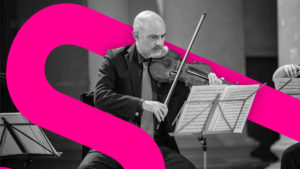
Flights of Fancy
Friday 25 April 2025
St. Martin-In-The-Fields
We bring you the music that made it big in the fashionable French capital including works by Ravel, Debussy and young Mozart.
Zee Zee
piano
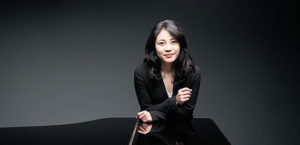
An imaginative and electrifying performer, Zee Zee, is unique among the young generation of pianists. Described as “full of enthusiasm and glamour, radiating the vigor of youth” (Chinese Gramophone), her interpretations and communicative abilities have been praised as “taking us to another reality… bright, expressive and moving to the extreme” (Belgischer Rundfunk), while her creative maturity has been hailed as “a powerful, passionate and compelling representation of pure artistry” (Los Angeles Times).
In the 23-24 and 24-25 seasons, Zee Zee returns to the BBC National Orchestra of Wales, Ulster Orchestra, Borusan Istanbul Philharmonic, Tucson Symphony Orchestra, Wigmore Hall, and Macao International Music Festival, among others. She debuts with the Armenian State Symphony Orchestra, Oxford Philharmonic, London Mozart Players, Szczecin Philharmonic, and at Concertgebouw, Prague Spring Festival, Minnesota Beethoven Festival, InClassica Dubai International Music Festival, Rafael Orozco Piano Festival, among others. She also plays the season-opening concerts of both the China Philharmonic and Shanghai Symphony Orchestra and tours with the cellist Pablo Ferrandez in Asia.
Highlights in the recent seasons include the season-opening concert with the Estonian National Symphony under Neeme Järvi, with the Philharmonia orchestra at the Royal Festival Hall, and a tour in the UK under Paavo Järvi, Three times with the Hong Kong Philharmonic under Christoph Koncz, Paavo Järvi, and Yu Long respectively, as well as the complete piano concertos of Beethoven and of Saint-Saëns with the Shanghai Symphony Orchestra. She also played at the Aspen Music Festival, Brevard Summer Music Festival, Lucerne Festival, Casa da Musica in Porto, Parnu Festival, Pietrasanta in Concerto Festival, Esplanade in Singapore, and Premiere Performance Hong Kong, among others.
In the past seasons, Zee Zee performed with leading orchestras worldwide including the BBC Symphony, BBC Philharmonic, BBC National Orchestra of Wales, London Philharmonic, Royal Liverpool Philharmonic, Philharmonia Orchestra, Belgian National Orchestra, Sinfonieorchester Basel, Tonhalle Orchestra Zurich, Borusan Istanbul Philharmonic, RTÉ Concert Orchestra, Macedonian Symphony, Warsaw Philharmonic, Janacek Philharmonic, Slovakia Philharmonic, Kristiansand Symphony, Turku Philharmonic, NHK Symphony, Hong Kong Philharmonic, Royal Bangkok Symphony, Los Angeles Philharmonic, San Francisco Symphony, Minnesota Symphony, Cincinnati Symphony, Seattle Symphony, Pasadena Symphony, Jacksonville Symphony, Pacific Symphony, Hawaii Symphony, among others. Zee Zee was a BBC New Generation Artist from 2013-2015 and performed at the Royal Albert Hall as a part of the BBC Proms.
Zee Zee has given a number of notable recitals, including at the Wigmore Hall in London, De Doelen in Rotterdam, Kennedy Center in Washington DC, Lincoln Center in New York, Vancouver Recital Society, and Hong Kong’s Premiere Performances, and has appeared at festivals such as MiTo Festival, the Gilmore Festival, Aspen Music Festival, Ravinia Festival, Brevard Music Center Summer Festival, Klavier-Festival Ruhr, Lucerne Festival, Biarritz Piano Festival and the SJE Arts Series in Oxford.
She regularly works with some of today’s leading conductors, including Marin Alsop, Jonathan Bloxham, Lionel Bringuier, Charles Dutoit, Alondra de la Parra, Domingo Hindoyan, Paavo Järvi, Neeme Järvi, Christoph Koncz, Michał Nesterowicz, Jun Märkl, Julian Rachlin, Yan Pascal Tortelier, Roberto Trevino and Xian Zhang.
A passionate chamber musician, Zee Zee is a founding member of the Z.E.N. Trio, alongside violinist Esther Yoo and cellist Narek Hakhnazaryan. The trio released their first album featuring works from Brahms and Dvorak in 2017, and the second album featuring Shostakovich, Babadjanian, and Rachmaninov in 2019, both under Deutsche Gramophone. They tour regularly throughout the world, including the first highly acclaimed tour in North America in October 2019 with presenters such as San Francisco Performances, The Phillips Collection, Vancouver Recital Society, a 10-concert-tour in Australia with Musica Viva in August 2022, and Europe tours in May & November 2024.
Zee Zee is the founder and the artistic director of the Z+ international music festival, which takes place annually in Spring in Shanghai. As one of the biggest and most acclaimed chamber music festivals in Asia, she is in charge of its strategy, vision, and programming, cooperating with the best musicians around the world while contributing to the local community. The Artists performing at the festival in 2024 include Clara-Jumi Kang, Sunwook Kim, Yura Lee, Ning Feng, Louis Schwizgebel, Julian Steckel, Esther Yoo, Haochen Zhang, and Diotima Quartet, and the artists in 2025 include Benjamin Beilman, Ray Chen, Lukas Geniusas, Paul Huang, Narek Hakhnazaryan, Denis Kozhukhin, and Calidore Quartet.
In October 2019, Universal released her first album under Deutsche Gramophone, featuring Ravel’s Piano Concerto in G and Liszt’s Piano Concerto No. 2 with Paavo Järvi and the Philharmonia Orchestra, the second one, a solo album
Zee Zee began her musical training in Berlin, Germany at the age of five and soon became one of the most sought-after young artists of her generation. Having completed her piano studies with Dan Zhaoyi at the Shenzhen Arts School, Zee Zee continued her artistic development under the mentorship of Nelita True at the Eastman School of Music and Yoheved Kaplinsky and Robert McDonald at The Juilliard School, where she won the coveted Petschek Piano Award. Zee Zee was awarded first prize at China’s 1st International Piano Concerto Competition, the Gina Bachauer International Artists Piano Competition, and the Krainev International Piano Competition. She was also a prizewinner at the 2013 Queen Elizabeth Competition. She has studied at the Peabody Institute with Leon Fleisher and continues to receive guidance from Alfred Brendel. She is currently based in Berlin and New York.
Jonathan Bloxham
conductor in residence and artistic advisor
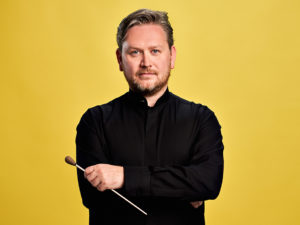
After first debuting with the orchestra in 2020 this season Bloxham begins his tenure as Chief Conductor of the Nordwestdeutsche Philharmonie following in the footsteps of Andris Nelsons and Jonothan Heyward, and conducting concerts on two German tours as well as in their subscription season in Herford. In 2021 he recorded a CD of Strauss and Franck with the orchestra, described as “irresistible” by Musicweb International.
Rosanna Rolton
Harp
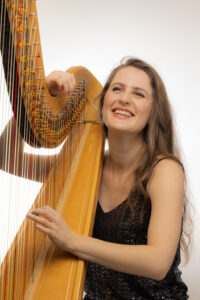
British/Dutch harpist, Rosanna Rolton was unanimously awarded 1st prize in the Suoni d’Arpa International Harp Competition 2014 and made her London solo debut in the Royal Festival Hall at the age of 20. Highlights of her recent solo engagements include the Wigmore Hall, Three Choirs Festival, the Royal Festival Hall, St. Martin in the Fields and BBC2-Encore. A frequent guest at music festivals and music clubs throughout the country, her solo recitals have also taken her abroad – most recently to Italy and Belgium. Rosanna’s debut CD was released in 2022 under the Italian Tactus label.
Alongside her solo career, Rosanna frequently works with the Budapest Festival Orchestra performing under conductors such as Iván Fischer and Marin Alsop, and playing in some of the world’s leading concert venues including New York Carnegie Hall, Amsterdam Concertgebouw and Hamburg Elbphilharmonie. She is also Principal Harpist of the London Mozart Players and Guest Principal Harpist of the City of Birmingham Symphony Orchestra, Aarhus Symfoniorkester in Denmark, Birmingham Contemporary Music Group and London Concertante. As principal harpist of the European Union Youth Orchestra from 2016 to 2018, Rosanna toured extensively throughout Europe and the Far East, working with conductors such as Vasily Petrenko and Gianandrea Noseda.
Much in demand as a chamber musician, Rosanna has most recently performed in Budapest and Ankara, playing Ravel’s sublime Introduction and Allegro. She regularly performs with her clarinet and harp duo throughout the UK and Italy, and is a founder member of the European Chamber Ensemble and member of the Cantiaquorum Ensemble.
Rosanna studied with Marisa Robles, Ieuan Jones and Daphne Boden at the Royal College of Music before continuing her studies with Ágnes Polónyi as part of the Budapest Festival Orchestra Academy.
She is co-Director of the Kidbrooke Park Music Festival – an annual classical music festival held in Sussex, UK.
Simon Blendis
leader
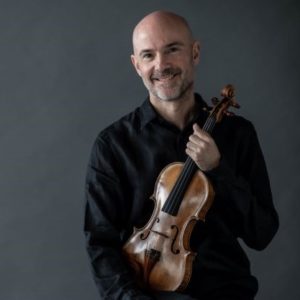
Simon joined LMP as leader in 2014. He was a member of the Schubert Ensemble for twenty-three years, from 1995 until the group retired in 2018, leaving a legacy of over 80 commissions, 25 CD recordings and a large library of live performances on YouTube.
Simon is in demand as a guest-leader and has appeared in this role with most of the UK‘s major orchestras. He has also appeared as a guest-director with orchestras such as the Academy of St. Martin-in-the-Fields, the English Chamber Orchestra, the Amsterdam Sinfonietta and the Scottish Ensemble. Since 1999 he has shared the position of leader of Orchestra Ensemble Kanazawa in Japan, with whom he has recorded Vivaldi‘s Four Seasons for the Warner label. As a soloist he has appeared with orchestras including the Philharmonia Orchestra, the RPO and the CBSO.
During the Coronavirus lockdowns Simon spent time researching the light music legacy of legendary violinist Max Jaffa. The resulting CD of 25 lost or forgotten gems from this archive, entitled Love is Like a Violin, was released in July 2022 to critical acclaim, and has already garnered over 4 million streams.
Increasingly sought after as a teacher, Simon is a professor of violin at the Guildhall School of Music and Drama.
